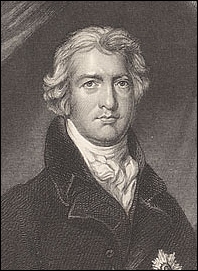Robert Jenkinson, 2nd Earl of Liverpool
Robert Banks Jenkinson, 2nd Earl of Liverpool (born June 7, 1770 in London - † December 4, 1828 in Kingston upon Thames , Surrey ) was a British statesman and Prime Minister of the United Kingdom from 1812 to 1827.
Life
Robert Jenkinson was the eldest son of Charles Jenkinson, 1st Earl of Liverpool , and a close advisor to George III. Robert Jenkinson was educated at Charterhouse School and Christ's College , Cambridge . On an educational trip to the European continent, he witnessed the storming of the Bastille in Paris in 1789 . In 1790 he was for the Tories to the British House of Commons voted. He was initially a member of the Control Commission for India (1793–1796) and finally head of the Royal Mint (1799–1801).
On March 25, 1795 he married Lady Louisa Theodosia Hervey († 1821), daughter of Frederick Hervey, 4th Earl of Bristol (1730-1803).
He held the courtesy title Viscount Hawkesbury from 1796 to 1808 , when he inherited his father's title. From 1801 to 1804 he was Secretary of State in Henry Addington's cabinet . In this office he reached the Treaty of Amiens with France. In William Pitt's cabinet Jenkinson was from 1804 to 1806 and under William Cavendish-Bentinck, 3rd Duke of Portland from 1807 to 1809 Secretary of the Interior. From 1806 he was also Lord Warden of the Cinque Ports . In the cabinet of Spencer Perceval he held the office of Secretary of State for War and the Colonies from 1809 to 1812 .
When Spencer Perceval was assassinated in May 1812, Lord Liverpool became Prime Minister. In his reign, the British triumphed over the French in the Napoleonic Wars , but failed to achieve a military triumph over the United States in the War of 1812 . The Congress of Vienna followed with an unstable peacetime. As before in his ministerial offices, he himself stayed in the background when making cabinet decisions and followed the advice of his advisors. Rather, his merit was to keep the two wings of the Tories in a common government. In 1827 he resigned after a stroke.
After his first wife died on June 12, 1821, he was married to Mary Chester († 1846) on September 24, 1822. Since he remained childless, his title of nobility fell on his death in 1828 to his younger half-brother Charles Jenkinson as 3rd Earl of Liverpool.
Individual evidence
- ^ Frederick Maurice Powicke, Edmund Boleslav Fryde: Handbook of British Chronology. Royal Historical Society, London 1961, p. 116
- ^ Frederick Maurice Powicke, Edmund Boleslav Fryde: Handbook of British Chronology. Royal Historical Society, London 1961, p. 115
- ^ Frederick Maurice Powicke, Edmund Boleslav Fryde: Handbook of British Chronology. Royal Historical Society, London 1961, p. 118
- ^ Alan Palmer, Veronica Palmer: The Pimlico Chronology of British History; from 250,000 BC to the Present Day. Pimlico, London 1996, ISBN 0-7126-7331-8 , p. 255
Web links
- Robert Bankes Jenkinson, 2nd Earl of Liverpool on thepeerage.com
literature
- Norman Gash: Jenkinson, Robert Banks, second earl of Liverpool (1770-1828). In: Oxford Dictionary of National Biography . Oxford University Press, 2004 ( online ).
- Norman Gash: Lord Liverpool. The Life and Political Career of Robert Banks Jenkinson, Second Earl of Liverpool 1770-1828. London 1984, ISBN 0571296378 .
- Charles Petrie: Lord Liverpool and His Times. J. Barrie, London 1954.
| predecessor | Office | successor |
|---|---|---|
| Charles Jenkinson |
Earl of Liverpool 1808-1828 |
Charles Jenkinson |
| William Pitt the Younger |
Lord Warden of the Cinque Ports 1806-1828 |
Arthur Wellesley, 1st Duke of Wellington |
| personal data | |
|---|---|
| SURNAME | Jenkinson, Robert, 2nd Earl of Liverpool |
| ALTERNATIVE NAMES | Jenkinson, Robert Banks, 2nd Earl of Liverpool |
| BRIEF DESCRIPTION | British politician, Member of the House of Commons and Prime Minister |
| DATE OF BIRTH | June 7, 1770 |
| PLACE OF BIRTH | London |
| DATE OF DEATH | December 4, 1828 |
| Place of death | Kingston upon Thames , Surrey |

